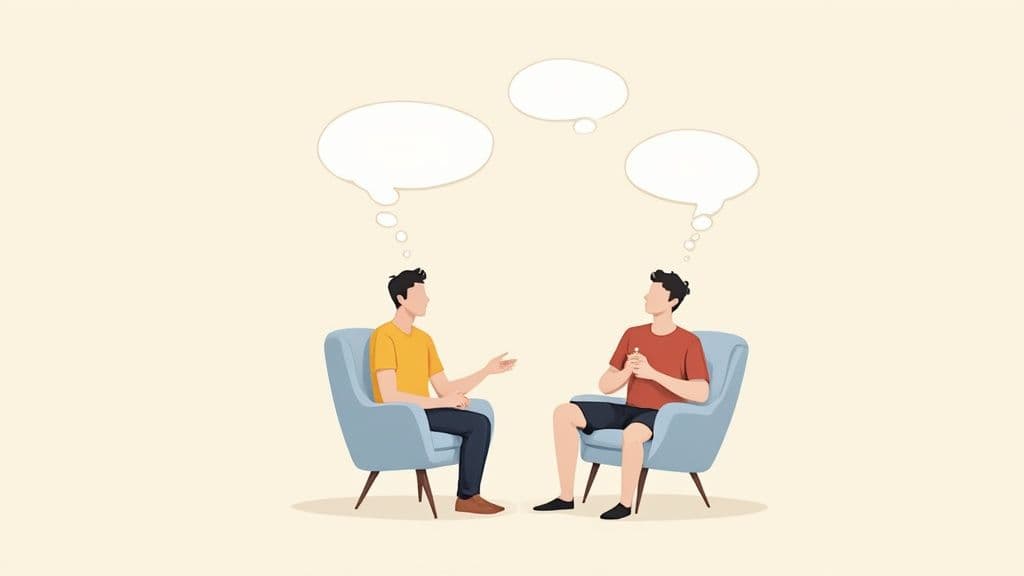Self-awareness isn’t about grand retreats; it’s about small, consistent moments of noticing. These short daily practices help you spot patterns in your thoughts, feelings, and reactions so you can make clearer choices, improve relationships, and reduce stress.
June 21, 2025 (5mo ago) — last updated November 27, 2025 (12d ago)
Daily Habits to Build Self-Awareness
Build self-awareness with short, science-backed daily habits to improve decisions, relationships, and emotional intelligence.
← Back to blog
Daily Habits to Build Self-Awareness
Summary: Practical, science-backed daily practices to build self-awareness and improve decisions, relationships, and emotional intelligence.
Introduction
Self-awareness isn’t about grand retreats; it’s about small, consistent moments of noticing. These simple daily steps help you observe your thoughts, emotions, and habits so you can make clearer choices, improve relationships, and reduce stress.
What Self-Awareness Looks Like in Daily Life

Self-awareness is the ability to notice your internal weather—thoughts, feelings, and physical sensations—without being swept away. It’s the pause between an event and your reaction.
Imagine a coworker gives blunt feedback. The automatic reaction might be defensiveness and a racing heart. A self-aware person notices that sting and thinks, “That comment made me feel angry and insecure; my chest is tight.” That observation creates space to choose a response rather than react, which usually leads to a more constructive conversation.
Real-World Impact on Decisions and Relationships
Self-awareness ripples across life. In a relationship, it’s the difference between lashing out because of work stress and saying, “I’m feeling overwhelmed and might be short; it’s not about you.” That clarity prevents needless arguments and builds trust.
Professionally, self-awareness is a core part of emotional intelligence; research links emotional intelligence to stronger workplace performance and leadership outcomes1. When you understand your motivations, strengths, and limits, you make career choices that fit your values and handle challenges with more confidence.
From Autopilot to Active Participation
Being self-aware means distinguishing the story you tell yourself from the facts. Instead of “I’m just an anxious person,” notice, “I feel anxious when a deadline approaches.” That shift turns you from a passenger into the driver of your life.
Day-to-day examples:
- Recognizing mental loops and redirecting attention.
- Turning down a higher-paying job because you value autonomy and know you’d be drained.
- Listening to criticism, separating useful points from the emotional sting, and responding constructively.
Self-awareness is a practice, not perfection. Small, consistent choices matter more than occasional dramatic efforts.
Building a Foundation for Honest Self-Reflection
Before exercises, carve out practical space for reflection and move past the inner voice that says you’re too busy. Treat reflection like data gathering: you wouldn’t make a major decision without information, so don’t navigate life without it.
Carving Out Small, Repeatable Time
You don’t need an hour every day. Find tiny pockets that fit your life:
- Busy parents: five minutes of silence after the school run—ask, “How am I really feeling right now?”
- Overwhelmed professionals: use the first minutes of lunch to check your breath and posture instead of your phone.
- Skeptics: while coffee brews, take two minutes to notice one recurring thought.
Consistency matters more than duration. Five focused minutes each day beats an hour once a month.
Quieting the Inner Critic
Your inner critic rushes to judge feelings before you can learn from them. Practice being a neutral observer: name a feeling without labeling it good or bad. Say, “I’m noticing anxiety,” rather than “I’m weak.” That small change creates distance and clarity. For guided approaches to less judgmental self-exploration, see how to learn about yourself and journaling practices.
Becoming Your Own Expert Observer
The observing self watches thoughts and emotions without judgment. It’s like the sky that holds all kinds of weather without becoming the storm. This practice gives you a moment to choose your response.
Identifying Emotional Triggers and Patterns
Track emotions a few times a day and label them—“stress,” “contentment,” “boredom.” Over weeks, patterns become visible. You might see a weekly spike in stress after checking work email at night.
Compare techniques to find what fits your life:
| Technique | Time Required | Difficulty | Best For | Key Benefit |
|---|---|---|---|---|
| Journaling | 10–20 minutes daily | Low | Unpacking complex thoughts | Written record; long-term patterns |
| Mindful pausing | 1–2 minutes, several times daily | Low | Breaking automatic reactions | Immediate space between stimulus and response |
| Body-scan meditation | 15–30 minutes daily | Medium | Noticing physical signs of emotion | Strengthens mind–body connection |
| Emotional check-in | 30 seconds, 3–5x daily | Low | Frequent awareness of current state | Builds habit and reveals trends |
Visualizing your emotional data can be eye-opening. An example chart might show 40% happiness, 35% stress, and 25% calm over a week—numbers you can work with instead of vague feelings.
For deeper insight into life themes and core patterns, long-form personality assessments and guided growth plans can help connect short-term data to long-term goals. See create a personal growth plan.
Using Others as Mirrors for Blind Spots

Some blind spots are invisible from the inside. Asking trusted people for specific feedback gives you data you can’t collect yourself. Many leaders think they are self-aware, but only a small percentage truly are2.
How to Ask for Useful Feedback
Avoid vague questions. Anchor requests to a behavior or moment:
- Colleague: “In this morning’s call, was there a moment my explanation got confusing?”
- Friend: “When we talked about your week, did I seem present or distracted?”
- Partner: “During our discussion about finances, what made you feel heard and what shut you down?”
These prompts help others give concrete observations rather than generalized impressions.
Receiving Feedback Well
When someone shares, listen and say, “Thank you.” Don’t defend or explain in the moment. Their perception is the data you asked for; evaluate it later. Treating feedback as a gift makes people more likely to share again.
Discovering What Drives Your Decisions
Values and beliefs act like an internal operating system. Many of us still run software installed years ago by family or culture. Conflicts between stated values and daily life often cause persistent frustration.
Distinguishing Authentic Values from Inherited Beliefs
When a decision feels off, trace it back to the belief that drove it. Ask:
- “What belief drove this choice?”
- “Where did I learn this was important?”
- “Does this belief support who I want to be now?”
This process helps you stop blaming the past and start choosing actions that reflect your current priorities. For structured exercises, see find your values.
Modern Tools That Actually Help
Pick tools that fit your goal. The personal development market continues to grow, showing steady demand for self-discovery resources3.
Matching Tools to Goals
Choose tools based on the insight you want:
- Mood-tracking apps: spot short-term emotional patterns and triggers.
- Meditation apps: increase present-moment awareness and reduce stress.
- Journaling apps: support deep reflection and long-term tracking.
- Personality assessments and life-path tools: reveal recurring themes and strengths.
A tool should show you the “what.” You still need to ask the “why.” Use data to form questions: if mood dips every Sunday, ask what you’re thinking or doing at that time and what that reveals.
Common tool categories and usefulness:
| Tool Type | Cost Range | Best For | Effectiveness | Example |
|---|---|---|---|---|
| Mood tracking | Free–$30/yr | Short-term patterns | ★★★☆☆ | Daylio |
| Meditation apps | Free–$70/yr | Mindfulness | ★★★★☆ | Calm, Headspace |
| Journaling apps | Free–$60/yr | Deep reflection | ★★★★★ | Day One |
| Life-path/AI tools | Varies | Deeper themes | ★★★★☆ | Life Purpose App |
| Personality tests | Free–$50+ | Interaction styles | ★★★☆☆ | Myers‑Briggs, Enneagram |
Turning Insights Into Real Change
Insight without action won’t move you. Start small: pick one specific behavior to change and practice it consistently. If you interrupt people, try pausing three seconds before speaking in your next conversation.
Choosing Where to Start
Focus on one manageable change. Small wins build momentum and make deeper shifts sustainable. See create a personal growth plan for a structured approach.
Overcoming Resistance
Resistance often comes from perfectionism and fear of others’ reactions. Aim for progress, not perfection. Celebrate small steps—pausing once before speaking is progress.
Digital tools can help translate insight into actions through reminders, habit tracking, and structured prompts.
Quick Practical Exercises
- Emotional check-ins: pause three times daily and name one feeling.
- Two-minute body scan: notice tension and breathe into it.
- Specific feedback request: ask one person about one recent interaction.
Concise Q&A
What’s the simplest daily habit to start with?
Begin with a 60-second emotional check-in three times a day—name one feeling and one bodily sensation.
How do I tell if feedback is a useful blind spot or just an opinion?
Anchor feedback to observable behavior and specific moments. Listen without defending; later, weigh whether it repeats across sources.
How long before I notice meaningful change?
Small daily habits—five focused minutes a day—often produce noticeable changes in weeks.
Three Practical Q&A Sections
Q&A: Time-Pressed People
Q: I’m too busy—what’s one tiny habit I can keep? A: Try a 60-second check-in three times a day—name one feeling and one bodily sensation. It’s short, portable, and builds awareness fast.
Q&A: Asking for Feedback
Q: How should I ask for feedback without sounding combative? A: Ask about a specific moment or behavior: “During our meeting, was there a time I seemed unclear?” Specific prompts invite concrete observations.
Q&A: Picking a First Tool
Q: What tool should I try first? A: Start with a mood-tracking or journaling app to collect basic data. Use that data to form questions about patterns, then try meditation or deeper assessments if needed.
Bottom-Line Practice Plan
- Pick one tiny habit (60-second check-in) and do it three times daily for two weeks.
- Track results with a simple app or journal entry.
- Ask one trusted person for specific feedback this week.
- Use findings to choose one behavior to practice consistently for a month.
Additional Concise Q&A Sections
Getting Started
Q: What’s the single most effective first step? A: Commit to five minutes of focused reflection each day and one 60-second check-in three times daily.
Feedback & Blind Spots
Q: How do I get honest feedback without defensiveness? A: Anchor your question to a specific moment and say, “I’m collecting observations; what did you notice in this interaction?”
Measuring Progress
Q: How will I know this is working? A: Look for repeatable changes: fewer reactive outbursts, clearer decisions, and patterns in your mood or journal entries over weeks.
Discover Your Life Purpose Today!
Unlock your true potential and find your life’s purpose.
